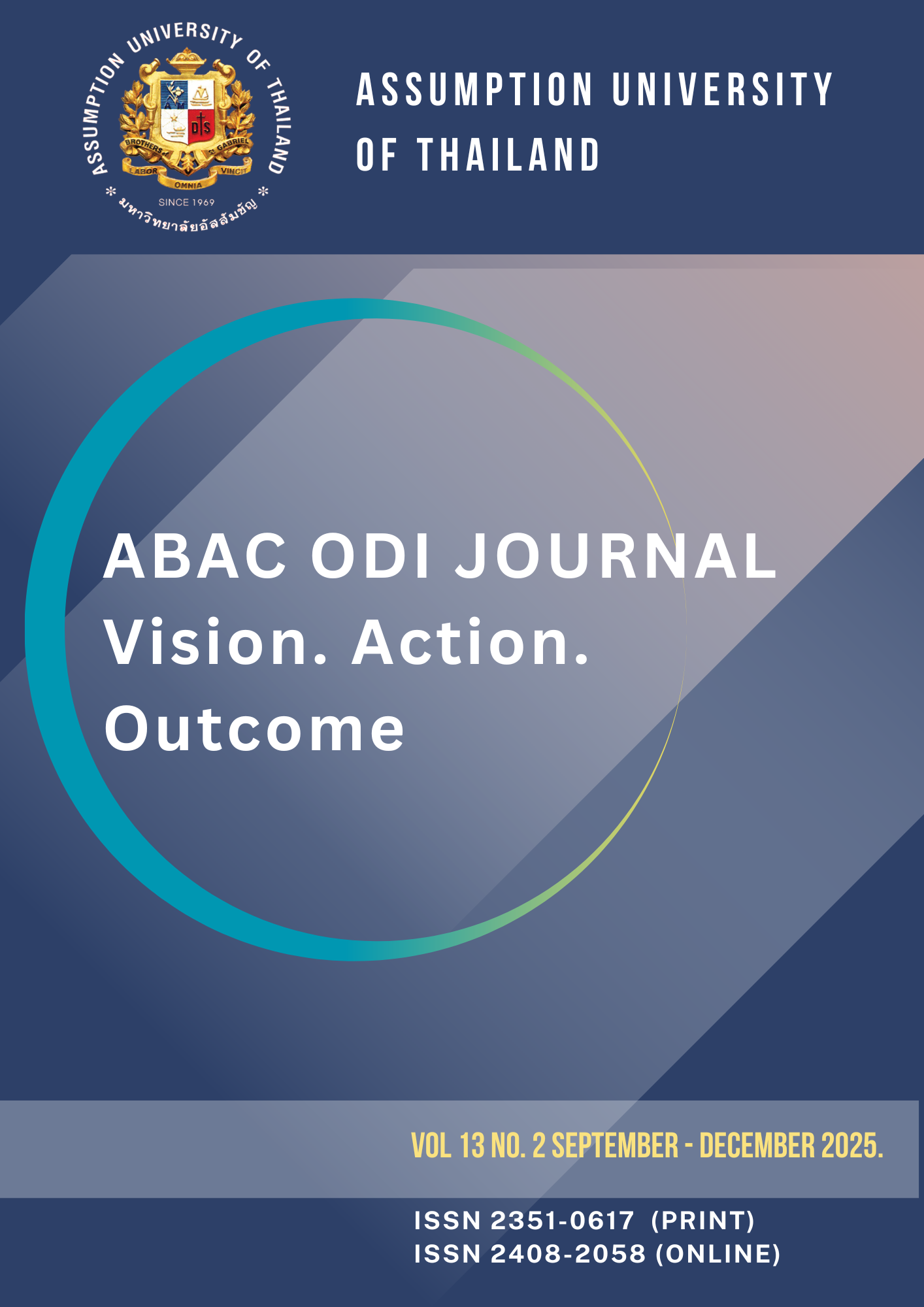Enhancing Work Engagement A Case Study of The Northeastern Regional Office of The National Human Rights Commission of Thailand
DOI:
https://doi.org/10.14456/abacodijournal.2025.42Abstract
Work engagement and retention are significantly influenced by a variety of intrinsic and extrinsic motivators, particularly in government organizations where salary structures and career paths are predetermined. In addition to monetary rewards, other motivations can be instrumental in inspiring employees to remain committed to the organization in the long term. This research aims to evaluate the intrinsic and extrinsic motivational factors that impact work engagement at the Northeastern Regional Office of the National Human Rights Commission of Thailand. Through a mixed-method approach grounded in the Appreciative Inquiry (AI) 4-D methodology, data were collected through individual and focus group discussions involving all 14 employees. Thematic analysis identified that meaningful work (intrinsic motivation) and a supportive work environment (extrinsic motivation) were the most important factors driving engagement. Employees found purpose in their contributions to society, while a physically and mentally supportive workplace further enhanced their dedication and motivation. Based on these insights, tailored recommendations were proposed to improve employee engagement by aligning organizational practices with these motivators.
References
Aggarwal, V. (2022). Resilience and work engagement among employees. International Journal of Indian Psychology, 10(3), 1879-1895.
https://ijip.in/articles/resilience-and-work-engagement-among-employees/
Chandrasekar, K. (2011). Workplace environment and its impact on organizational performance in public sector organizations. International Journal of Enterprise Computing and Business Systems, 1(1), 1-19.
https://www.ijecbs.com/January2011/N4Jan2011.pdf
Conger, J. A., & Kanungo, R. N. (1988). The empowerment process: Integrating theory and practice. Academy of Management Review, 13(3), 471-482.
https://www.jstor.org/stable/258093
Cooperrider, D. L., & Whitney, D. (2005). A Positive Revolution in Change: Appreciative Inquiry. The change handbook: The definitive resource on today's best methods for engaging whole systems.
Deci, E. L., Olafsen, A. H., & Ryan, R. M. (2017). Self-determination theory in work organizations: The state of a science. Annual Review of Organizational Psychology and Organizational Behavior, 4(1), 19-43.
https://doi.org/10.1146/annurev-orgpsych-032516-113108
Fernandez, S., & Moldogaziev, T. (2013). Employee Empowerment and Job Satisfaction in the U.S. Federal Bureaucracy: A Self-Determination Theory Perspective. The American Review of Public Administration, 45(4), 375-401.
https://doi.org/10.1177/0275074013507478
Gannon, D., & Boguszak, A. (2013). Douglas Mcgregor’s Theory X and Theory Y. Cris - Bulletin of the Centre for Research and Interdisciplinary Study.
https://www.researchgate.net/publication/269476091_DOUGLAS_MCGREGOR'S_THEORY_X_AND_THEORY_Y
Kovalchuk, L., Buono, C., Ingusci, E., Maiorano, F., De Carlo, E., Madaro, A., & Spagnoli, P. (2019). Can Work Engagement Be a Resource for Reducing Workaholism’s Undesirable Outcomes? A Multiple Mediating Model Including Moderated Mediation Analysis. International Journal of Environmental Research and Public Health, 16(8), 1402. https://doi.org/10.3390/ijerph16081402
Locke, E. A., & Latham, G. P. (1990). A Theory of Goal Setting & Task Motivation. Prentice Hall.
https://www.researchgate.net/publication/232501090_A_Theory_of_Goal_Setting_Task_Performance
Lussa, M. F., Sudiro, A., & Hapsari, R. D. V. (2023). The effect of work motivation and work environment on employee performance through work engagement. International Journal of Research in Business and Social Science, 12, 134-143.
20525/ijrbs.v12i9.3063.
MacCoy, D. J. (2014). Appreciative Inquiry and Evaluation - Getting to What Works. The Canadian Journal of Program Evaluation, 29, 104.
https://utppublishing.com/doi/pdf/10.3138/cjpe.29.2.104
Maslow, A. H. (1954). Motivation and Personality. Harper & Row.
https://archive.org/details/in.ernet.dli.2015.198216
Montauban, N. (2023, September 11). Work engagement theory and how to measure work engagement. Survey Analysis and Reporting Automation.
https://sara-hr.io/work-engagement-theory-and-how-to-measure-work-engagement/
Ozsoy, E. (2019). An empirical test of Herzberg’s two-factor motivation theory. Marketing and Management of Innovations, 1, 11-20. https://doi.org/10.21272/mmi.2019.1-01
Pierce, J. L., & Gardner, D. G. (2004). Self-esteem within the work and organizational context: A review of the organization-based self-esteem literature. Journal of Management, 30(5), 591-622. https://doi.org/10.1016/j.jm.2003.10.001
Ribeiro, M. F., Costa, C. G. D., & Ramos, F. R. (2024). Exploring purpose-driven leadership: Theoretical foundations, mechanisms, and impacts in organizational context. Administrative Sciences, 14(7), 148. https://doi.org/10.3390/admsci14070148
Rodriguez, J., & Walters, K. (2017). The Importance of Training and Development in Employee Performance and Evaluation.
Rokach, A., & Goldberg, J. O. (2021). Editorial: From loneliness to belonging - the path we hope to take. Frontiers in Psychology, 12, 761440.
https://doi.org/10.3389/fpsyg.2021.761440
Ryan, R. M., & Deci, E. L. (2000). Intrinsic and extrinsic motivations: Classic definitions and new directions. Contemporary Educational Psychology, 25(1), 54-67.
https://doi.org/10.1006/ceps.1999.1020
Slavich, G. M., & Cole, S. W. (2013). The emerging field of human social genomics. Clinical Psychological Science, 1(3), 331-348. https://pubmed.ncbi.nlm.nih.gov/23853742/
Steger, M. F., Dik, B. J., & Duffy, R. D. (2012). Work as meaning: Individual and organizational benefits of engaging in meaningful work. In K. S. Cameron & G. M. Spreitzer (Eds.), The Oxford handbook of positive organizational scholarship (pp. 131-142). Oxford University Press.
Swe, K. T. H., & Lu, L. H. (2019). The Enhancement of Employee Engagement to Reduce Employee Turnover Intention and Improve Employee Job Satisfaction: An Action Research on Mirac Company in Yangon, Myanmar. ABAC ODI JOURNAL Vision. Action. Outcome, 6(1), 123-147.
https://assumptionjournal.au.edu/index.php/odijournal/article/view/3238/pdf
Vaessen, I. (2021). The Self-Determination Theory and Work Engagement: The Role of Extraversion at the Workplace. Department for Developmental Psychology. Tilburg University http://arno.uvt.nl/show.cgi?fid=157781
Van Der Voordt, T. J. M. (2004). Productivity and employee satisfaction in flexible workplaces. Journal of Corporate Real Estate, 6(2), 133-148.
Vithayaporn, S., & Ashton, A. S. (2019). Employee Engagement and Innovative Work Behavior: A Case Study of Thai Airways International. ABAC ODI JOURNAL Vision. Action. Outcome, 6(2), 45-62.
https://assumptionjournal.au.edu/index.php/odijournal/article/view/3881
Wardiansyah, D. R., Indrawati, N. K., & Kurniawati, D. T. (2024). The effect of employee motivation and employee engagement on job performance mediated by job satisfaction. International Journal of Research in Business and Social Science, 13, 220-231. 10.20525/ijrbs.v13i1.3133.
Yang, Y., & Chungviwatanant, S. (2022). Designing Interventions to Enhance Employee Engagement among Administrative Employees at Heilongjiang International University. ABAC ODI JOURNAL Vision. Action. Outcome, 9(2), 144-160.




